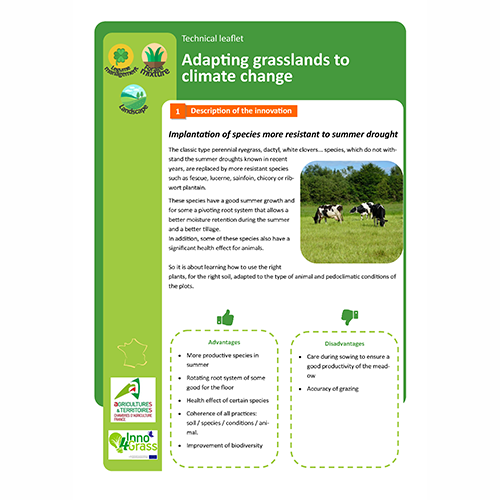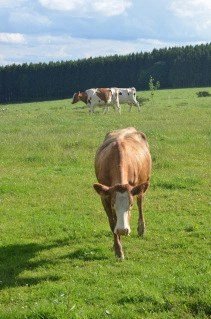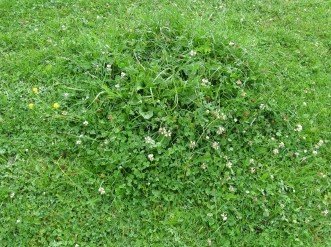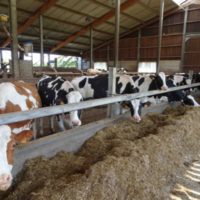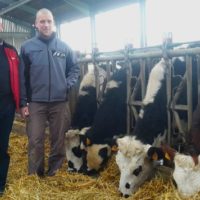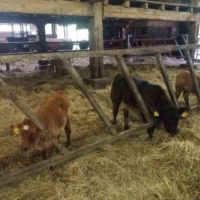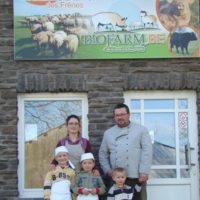Short-grass grazing
Description
Description of the innovation
Maintaining a low grass height provides quality forage throughout the dairy cow’s graz-ing season. The short grass grazing technique consists in letting dairy cows graze on a single plot, possibly several, keeping a constantly low grass height between 6 and 8 cm. This grazing system has the advantage of reducing the farmer’s workload and offering young grass throughout the grazing season. However, maintaining a short grass height and keeping homogeneous plots requires careful management of the grasslands.
In practice, it is recommended to start the season with 30 acres per cow. In May, when the growth is in full swing, 20 acres per animal are enough to contain the height of the grass. In July, the available area is again enlarged to 40 acres per cow.
The goal is that the grass does not go to seeds. This technique provides a grass of excellent quality that is very lactogenic. The requirement being to have the climatic conditions required. Short grass graz-ing can only be envisaged in areas where summer growth is continuous, with regular rainfall, espe-cially in summer. Having temperatures adapted to growth is also essential.
Precise grazing management is the key to success. The growth of the grass has to be monitored permanently. When it is likely to exceed 10 cm, it is better to reduce the available surfaces. The optimal grass height is between 6-7 cm in the spring and 8-9 cm in the summer (herbometer measurements). The plots put aside will then be mown when the time comes, then immediately reo-pened for the animals to graze. Grazing has to start immediately, preventing that the grass gets too long, creating an imbalance with the rest of the surfaces. Fodder supple-mentation is also adjusted according to the evolution of the grassland. An intake of 2 to 3 kg of hay can be added to the ration. Supplementation in hay can be useful but must remain limited to 3 kg / cow / day as long as there is enough grass in the plot.
One of the main interest of the technique is the simplification of the work. No more wires or water tanks to move. In addition, the grass has a consistently high nutritional value, providing a stable basic ration. The bearing capacity of the soil is improved and the cows are calmer.
Regarding fertilization, it is better not to add too much soluble nitrogen so as not to overfeed the grasslands and allow clover to resist compared to ryegrass. In practice, it is recommended not to exceed 25 units of nitrogen at each passage, with three to four passages maximum.
Results obtained with the adoption of the innovation
Regarding the milk production, it does not increase systematically. But the lactation is more stable and the persistence is improved. Smaller and fewer swings in the fat and protein content of the milk are also observed. Milk production stays in a very good range considering that the production is mainly forage based.
Farmers also report that the health of the livestock is better. For instance, they ob-serve a strong diminishing in milk fever cases at the beginning of the lactation. Cows always have a very protein rich digestible grass. The low height of grass imposes in-tensive and regular grazing and so the production of a lot of saliva, which prevents acidosis.
Regarding the meadow, the maintenance of a short height pasture favors leafy grasses (high tillering of the perennial ryegrass) at the expense of upright grasses. The light also benefits white clover, which can reach 40% of the meadow in some areas after 4 years. The rapid thickening of the “grasscarpet”, observable from the 2nd year on, improves the bearing capacity of the meadow and its resistance to trampling in wet conditions. In addition, the density of vegetation cover prevents the development of weeds. It constitutes a means of fighting the development of Rumex: the young leaves are regularly consumed by the livestock, which contributes to the exhaustion of the plant. Nevertheless, this system seems to favor the devel-opment of the stoloniferous bentgrass, responsible for significant yield losses, and lack of cover. As for the yield of the meadow, overall, it is maintained thanks to the density gain (+ 30% in 5 years) and to the reduction of waste.
However, the absence of standing grass stock makes the system more fragile in case of prolonged growth stop. Also, obtaining a regular grass requires plots of homoge-nous forage potential and topography. Animals spend more time on the best surfac-es and further enhance the heterogeneity of the plot, especially regarding the grass height.
Continuous grazing on short grass quickly proves its effectiveness. Easy to set up, without investment and always reversible. It still attracts new followers among young farmers and few go back to rotational grazing. Some farmers adapted the original technic to fit different contexts and aims, both in conventional and organic farming.
Advantages
- Reducing the farmer’s workload
- Simplification of the work
- Offering young grass throughout the grazing season
- Consistently high nutritional value
- Yield of the meadow is maintained
- Improved bearing capacity of the soil
- Calmer cows
- More stable and persistent lactation
- Stability of the rates in the milk
Disadvantages
- Needs careful management of the grasslands
- Does not increase systematically milk production
- Requires plots of homogenous for-age potential and topography
- More fragile system in case of pro-longed growth stop
Why the innovation works
This type of grazing system can be adapted an a lot of farms. The most im-portant condition for short grass grazing is to have enough available grazing surfaces around the farm. It should be possible to make 1 or 2 big plots with a total of 0.30 ha per cow. There is not really a need for over sawing the pas-ture. The vegetation adapts itself to this grazing method. There is not much to do besides adjusting the size of the pasture to the growth rate of the grass. The breeding of the herd towards a more adapted breed to grazing as well as the seasonal calving are both options that enhance even more the productivi-ty of the grassland.
More information
- Thomet P., et al., 1999. La pâture continue sur gazon court, fiche technique ADCF Ib 8.2.2
- http://www.fourragesmieux.be/Documents_telechargeables/Le_paturage_des_prairies_permanentes_Cremer_2015.pdf
Additional information
| Domains of innovation | grazing management system |
|---|---|
| Main types of animal | dairy cattle |
| Country | Belgium |
| Product type | Technical leaflet |
| Language | English, French |
